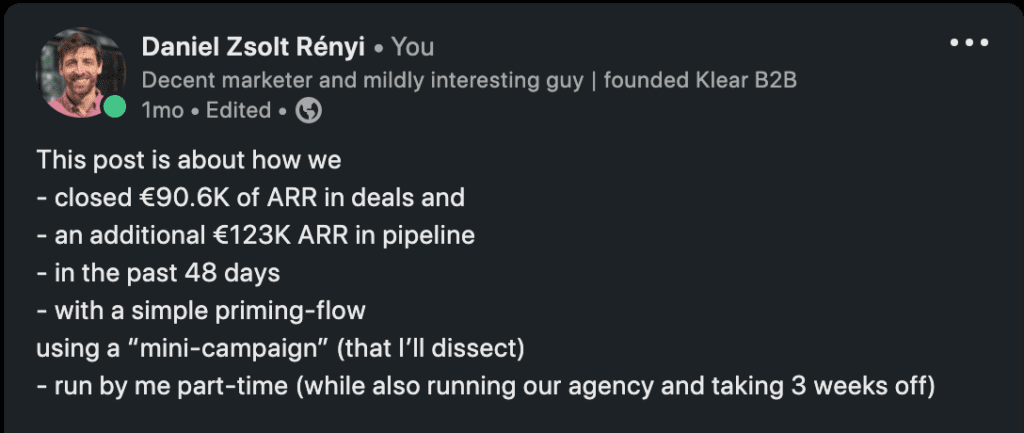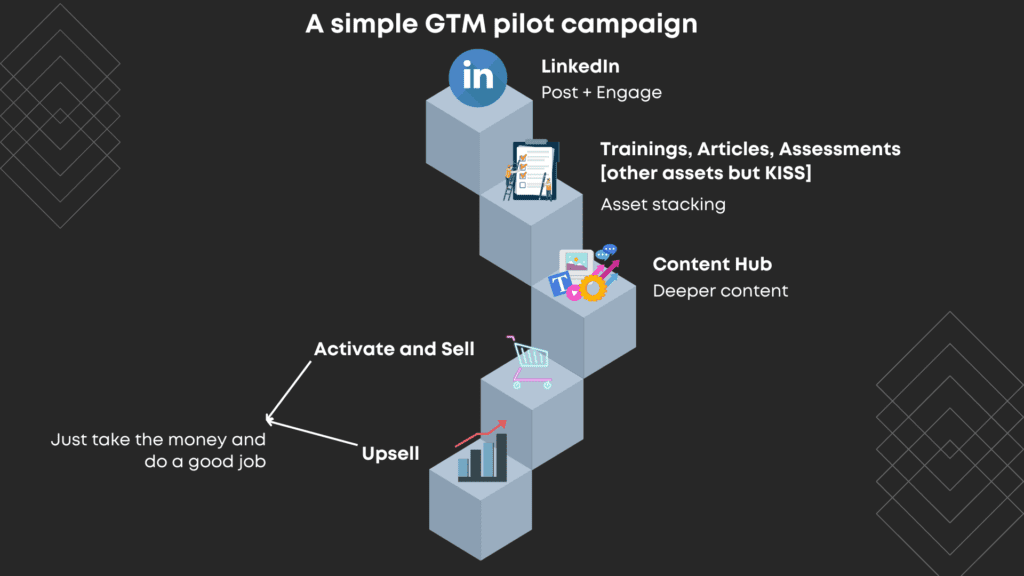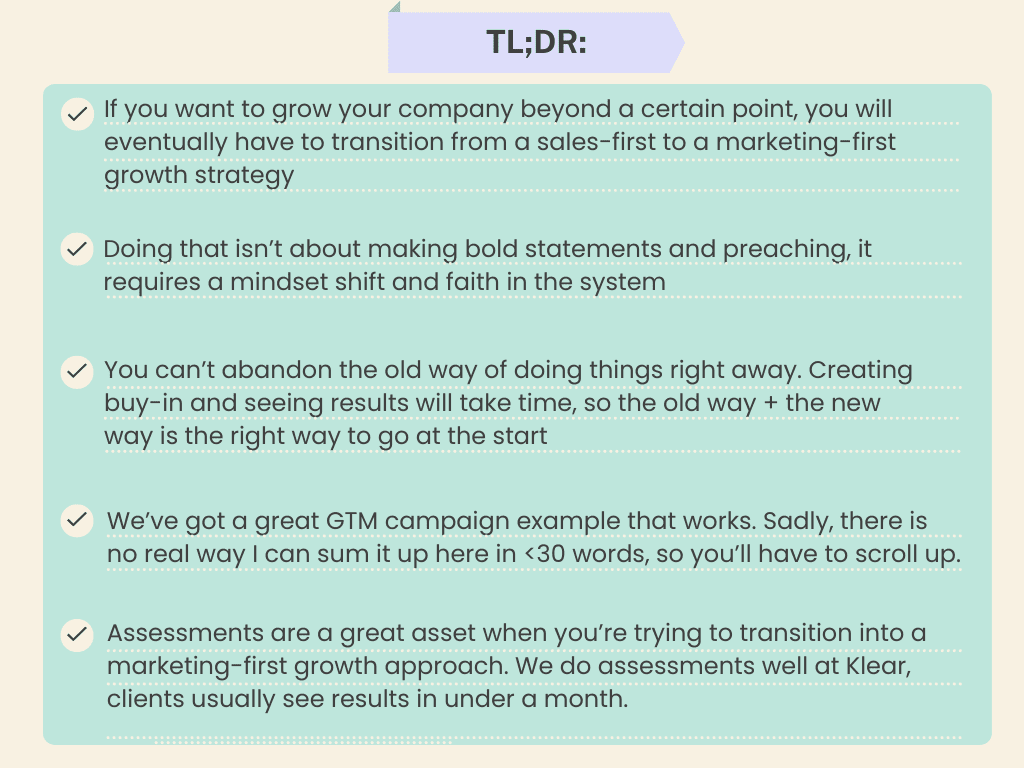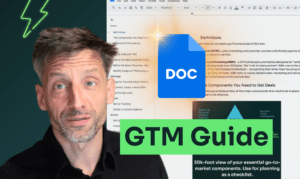At Klear, we’ve been talking a lot about how transitioning from sales-first growth to marketing-first growth is essential for companies. If you’ve been following us on our socials, you probably already know that. (If you aren’t, here’s a shameless plug: find us here)
Recently, we conducted an hour long training session where we discussed:
- The progressive way of growing technology companies
- A step-by-step system of how to launch transformation from sales-led to marketing-led growth
Let’s dive in.
What’s sales-led growth?
Sales-led growth essentially means using a sales-first approach to getting clients & customers for technology companies. If you’ve ever heard about or read up on how technology companies like IBM sold software back in the day, say in the late 1940’s, you already know what sales-first means.
Back then, selling was primarily a sales function. (Marketing wasn’t even a thing yet.) Salespeople actively went out there and sold to companies—it started with knocking on doors and shifted to calling them up, faxing them, paging them, whatever it took.
Eventually, marketing was introduced in the mix. But even then, marketing was only the sidekick. Like Robin to Batman, Dr.Watson to Holmes, or Dwight to Michael Scott, you get it.

And that’s how it’s been for a while now. It does work for a few industries, and maybe yours is one of them.
But there’s a catch. (Ah, isn’t there always?)
It’s not sustainable. The sales-led approach isn’t working, and going forward, it’s going to work less and less.
Why does sales-led growth not work anymore?
1. Huge competition in MOFU and BOFU:
70 years ago, IBM was the only one doing what it did. It had practically 0 competition. Now, at least 30 other profitable, equally established companies are doing that.
Just look at it this way, a 100 years ago, sliced bread wasn’t a thing. Now you not only have sliced bread, you have flavored, gluten free, dairy free, preservative free sliced bread cut diagonally, straight across or in circles too if you please, by 50 different bakeries, even in a small town. And this is just sliced bread. Simply put, no matter what you sell, you’re going to have competitors, and some are going to be doing it better than you.
This means that you and your competitors are all on the same playground, fighting to win the few customers that are already looking to buy. Statistically, that’s 3% of the market. There are sophisticated players out there trying to generate demand, but they’re few in number.
2. Buyers do not want to talk to salespeople
I don’t remember the last time I wanted to buy anything and I picked up the phone and called up the salesperson or signed up for a demo. You have everything on the internet anyway. Most decision makers these days that fall in the <40 y.o category would rather Google for a few hours than spend 30 mins talking to a salesperson.
It’s only after that they’re decided on a few options that they’d even consider calling someone up. The intention then clearly, isn’t information gathering.
3. If you generate demand, you win.
Like the 3% of the market that is ready to buy, there’s the 97% that isn’t. When companies target audiences that aren’t ready to buy and make them aware of their pain points, they win deals when the customer is ready.
What’s marketing-led growth?
It’s a mindset and growth strategy where customer insight drives engaging buying experiences. Ofcourse, you start with launching marketing in a sales-first organization and progressing through the stages of the ABM framework. Essentially, it’s growth that:
- Supports ongoing qualitative and quantitative customer research
- Maximizes buying experiences
- Facilitates close collaboration between marketing and sales
- Is not just a once-off activity but a culture and mindset shift
- Is not a set of tactics or quick fixes
- Rests on creating demand
But, switching to a marketing-led growth strategy sounds like a lot of work, and it probably also is. If sales-led growth is working out for you, is all the work needed to transform into a marketing-first company worth it?
Okay, so here’s the thing: sales-first approach works. But only to a certain extent. After a point, you need to switch to marketing first. A sales-led growth strategy will get you only so far, but a marketing-led one will help you move forward.
How do you implement the marketing-first approach?
Because there are multiple ways to go about this, we don’t want to give you a 2 page pdf that details how you can create a mindset shift and succeed at taking a marketing-first approach to growth. Because:
- Not all organizations have the same goals. They all look different.
- And we have no idea what it looks like at your organization.
But, we can show you how we’ve done it and tell you about the results. Here’s what Klear achieved recently (and the LinkedIn post inspired by it):


Implementing a marketing-first growth strategy isn’t about an overnight shift in the way of doing things, it’s a gradual process towards prioritizing marketing.
And here’s how we made it happen:
- Social selling
- Interactive assessments
- Asset-stacking
The idea here isn’t to create a framework that pushes people down further into the funnel. This is about creating buyer journeys. You need to empower the customer to self-serve themselves.
How do you make this happen?
- Preaching isn’t enough
Talking it over with your team or having conversations about this internally isn’t enough. Oh and ofc, announcing it on social media doesn’t do much either. A mindset shift isn’t going to happen from a 2 hour webinar from an SME. We need to focus on doing and believing more than talking about it.
2. You can’t ditch leadgen from day one
You don’t get to abandon ship before proving that marketing-led growth works. Don’t stop funding lead gen and pump all your money into demand gen.
3. Prove your new game while getting results in the old one
Again, don’t stop working on the old one, work on both together at first.
How do you plan, set-up and run a campaign?
To make all this happen, you need an actual, actionable plan. That’s the easiest way to get buy-in, and that is only step one.
Then, you set up goals and expectations and actually design a campaign, run it and share results with your team(s). And then you do it all over again.
Klear has a formula for a simple, GTM pilot campaign. The formula goes something like this:

The GTM pilot campaign is capable of getting you leads and insights. The first 3 main components are pure marketing and the last two components, you hand over to sales.
The real, meaty part here is demand generation that happens through creating engaging LI posts that resonate with people, and interactive assessments that provide you with a ton of insights.
You’d also want a bunch of other assets like calculators or webinars and not just depend on assessments. But here, we’re abiding by KISS principles and keeping it super simple.
Why assessments?
Assessments are currently the fastest way to get prospecting insights and leads. They ideally have a great hook that grabs attention, aren’t a common marketing asset and have the power of novelty.
They’re also interactive and provide a lot of value to the buyer in a short amount of time + you get great market research data out of it. The gamification also makes the entire process easier for the audience.
The process of creating a quiz looks something like this:
You start off by giving them anywhere between 5-12 prospecting questions. Once they’re done with the quiz, you give them a brief assessment and based on that, you suggest the next steps.
We’ve seen wonderful results for the quiz-led campaign that we did. Let’s talk about how we’ve done it and how you can do it too.
How do you set up a lead-gen and demand-gen sprint?
At Klear, we’ve done this multiple times, and here’s how our usual process goes:



Related Posts
- Launching Marketing at a Sales-First Organization - ep 31
https://www.youtube.com/watch?v=KVEjYFSF00s&ab_channel=KlearB2B If you’re a sales focused company looking to pivot to stage 5 of the…
- SDR superpowers for account-based marketing - ep 8
Be'Anka Ashaolu, VP of Marketing at Propel and Dan from Klear dive-into some exciting parts…
- The simple B2B growth-marketing play - ep 3
Can you have success with almost zero marketing? Some believe it’s possible. Up to a…

